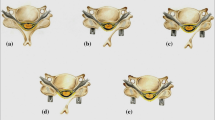Abstract.
Several anterior and posterior methods are today available for stabilization of the cervical spine. Factors such as level and degree of instability, method of decompression, bone quality, length of fixation and safety factors influence the choice of method for a particular patient. The use of laminar hooks in the cervical spine has been restricted by fear of cord compression with the potential of tetraplegia. The aim of the present study was to assess the safety and determine the anatomical relation between hooks inserted in the cervical spinal canal and the dura and spinal cord. Thirteen cadavers from seven women and six men with no evidence of cervical spine disorder were included. The mean age was 81.3 years (range 65–101 years). The cervical spine was instrumented with cervical Compact Cotrel Dubousset hooks and rods. The effect of the hook on the dura was studied by myelography in nine cadavers. The deformation of the dural sac was quantified by measurement of the maximal width of the indentation of the contrast column at each level. A CT myelography scan was obtained in three cadavers. The ratio between the distance of maximal hook intrusion into the spinal canal and the canal diameter in the direction of the hook was calculated. The relation between inserted hooks and the spinal cord and dura was documented in a fresh cadaver studied with CT myelography. A hemilaminectomy was performed at all levels in three cadavers with direct visual inspection and photography of the hook sites before and after excision of the dura. A dural deformation of 2 mm or less, as observed by myelography, was found at four out of 77 (5%) hook sites. The deformation was caused by a supralaminar hook at C3, C6 and C7 and by an infralaminar hook at C6. The mean hook intrusion in the spinal canal, as observed on CT, was 27% (range 8–43) of the canal diameter. On visual inspection, 14 out of 18 hooks were in contact with the dura. After removal of the dura, two out of the 18 hooks in the same cadaver were in contact with the spinal cord. However, no deformation of the cord was observed. To our knowledge this is the first study systematically documenting the relation between hooks and the spinal cord in cadavers. In 95% of the hooks no deformation of the dural sac was observed and there was no evidence of spinal cord deformation. From an anatomical point of view, laminar hook instrumentation can be considered a safe procedure. The study shows, however, that hooks inserted in the cervical spine have a close anatomical relationship with the neuraxis, and at stenotic levels the use of other techniques is therefore recommended.
Similar content being viewed by others
Author information
Authors and Affiliations
Additional information
Electronic Publication
Rights and permissions
About this article
Cite this article
Fagerström, T., Hedlund, R., Bancel, P. et al. Laminar hook instrumentation in the cervical spine. An experimental study on the relation of hooks to the spinal cord. Eur Spine J 10, 340–344 (2001). https://doi.org/10.1007/s005860100251
Received:
Revised:
Accepted:
Published:
Issue Date:
DOI: https://doi.org/10.1007/s005860100251




